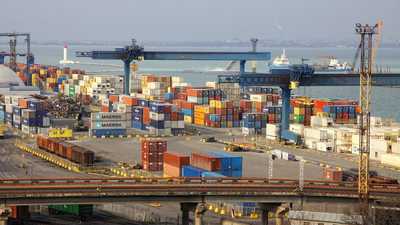| Home | About | Archives | RSS Feed |

The Retired Investor: No-Shows Threaten Economy
 |
Last week, economists calculated that almost 5 million workers failed to show up at their jobs. Given the present upsurge in cases of the Omnicom variant, that should come as no surprise. However, it clearly has Wall Street economists reducing their estimates of first quarter 2022 GDP.
Slower economic growth normally has a negative impact on everything from the stock and bond markets, interest rates and employment. How this will ultimately affect the economy in the months ahead is a question worrying every trader and portfolio manager in the financial markets.
The first warning sign that this wave of coronavirus infection was impacting business came during the holidays. Thousands of flights, we thought, were canceled due to weather-related concerns and maybe some no shows due to the holidays. It soon became apparent that employees from pilots to baggage handlers and everyone in between were getting sick, or forced into quarantine, by the omicron variant.
Since then, a wave of omicron infections has decimated the working forces of supermarkets, shipping ports, transportation hubs, and a variety of factories and food processors throughout the country. I am starting to notice this personally. Just Wednesday, as I stood in a long line at my local supermarket, I noticed the lines seemed to be getting longer, even though holiday shopping is long over.
First, my concern was simply maintaining the 6 feet of spacing since most shoppers were ignoring the footprint markers behind me. Masked, gloved, and behind a plexiglass partition, my turn finally came. I asked the clerk why the lines were so long.
"A lot of people are out sick," said the weary, masked clerk. "So why not hire more people?" I asked. In response, she just laughed, nodding towards the "help wanted" signs behind her. I noticed her nose was poking out from the top of her mask. I held my breath.
The clerk also lamented that her schedule was in chaos, since no one knew which employees would be sent home tomorrow to quarantine, or who would be sick and how long it would be until they returned. "It's the same kind of thing you normally see when there is a big snowstorm. Some make it in, most don't."
And what is happening stateside is also developing throughout the globe. Europe has been struggling with the same issues. China, due to their strict isolation policies, has been managing somewhat better than most countries — until recently. This week, China's Zhejiang Province, home to one of the country's key ports, has suspended or greatly reduced the transportation of manufactured goods and commodities into Ningbo port, thanks to an outbreak of omicron last week.
Unfortunately, Ningbo is one of a handful of the world's largest container ports and an integral link in the world's supply chain connecting producers in East China with buyers of everything from automobiles, electronics, semiconductors, heavy equipment, machines, clothes and even toys. A second major port city, Dalian, a city of 7 million, announced its first cases of omicron Jan. 12, threatening the closure of its port. As a result, ships are heading for Shanghai's huge container port, which is causing congestion and delaying shipments by at least a week.
In August 2021, the port was shut down for a couple of weeks because of COVID-19. Analysts estimated it cost the world about $4 billion a week during that shut down. As it stands, global shipping ports have been working to reduce the congestion that has stranded an armada of container ships along their shores. Here in the U.S., the government has made efforts to relieve the port congestion in Los Angeles. On the East Coast, the New Jersey and New York ports have until recently managed to keep up with port congestion. However, omicron is steadily reducing the number of longshoreman available. As a result, the line of ships building off the coast of Long Island is increasing daily.
During the course of the last week, several economists have downgraded their forecasts for the first quarter 2022 GDP. Some are simply postponing growth, pushing it out to the second quarter. Economists are arguing that while Omicron may hurt growth in the short-term, the variant will flare out, and growth will resume in time to show higher by May or June. Let's hope they are right.
Bill Schmick is the founding partner of Onota Partners, Inc., in the Berkshires. His forecasts and opinions are purely his own and do not necessarily represent the views of Onota Partners Inc. (OPI). None of his commentary is or should be considered investment advice. Direct your inquiries to Bill at 1-413-347-2401 or email him at bill@schmicksretiredinvestor.com.
The Retired Investor: My Dog's Medical Bills Are Higher Than Mine
 |
On the surface, it was a good year if you were in the veterinary business. Year-over-year sales grew by 9.1 percent, while patient visits increased by 3 percent. For pet owners, however, not so much.
Owners found that the cost of keeping their pets healthy jumped by about 10 percent. Some of that price increase was due to higher fees, but consumers were also purchasing more products and services.
My chocolate Labrador Retriever, Titus, is now 13 years old. The rule of thumb: every year of a dog's life equals seven years of my life. That would put Titus' age at 91, versus my age of 73. I won't detail all his health ailments, suffice it to say that he is in the vet's office just about every other week. Those visits last for 30-60 minutes and we usually leave with medications. The cost fluctuates between $175 and $375 per visit (not counting the meds). In contrast, I saw my doctor twice last year and the one medication I take is free.
Just like human medicine, veterinary medicine is experiencing new advances and frequent discoveries. Universities and pharmaceutical companies worldwide are stepping up their research, conducting quality trials, and achieving breakthroughs that are providing an entire range of modern medicines. As such, surgical procedures are now commonplace. Conditions, which in the past would spell end-of -life decisions by owners, are now treatable.
Pet cancer treatments, for example, were practically unheard of twenty years ago. Today, the Veterinary Cancer Society estimates one in four dogs will develop cancer (and almost 50 percent of dogs over the age of 10). As a result, more and more vets are treating cancer, but at a cost.
Specialist visits to confirm cancer can run upwards of $1,500. Treatments are expensive — chemotherapy ($200-$5,000), radiation ($2,000-$6,000), drugs ($50+ per month). A cancerous pet can set you back $10,000 or more. And unfortunately, more and more pets are showing up with cancer.
To make matters worse, there is no such thing as Medicare for your dog. That means there is no government program to reimburse the veterinarian cancer hospitals, so they pass the full costs on to the pet owner.
What about pet insurance, you may ask? Unfortunately, many new pet owners don't feel the need to buy insurance for their pet until after it is too late. But even if you have pet insurance, most policies only cover half the cost, and typically pet insurance requires that you pay upfront.
Titus doesn't have cancer, thank goodness, but he did have a herniated disc where his tail meets his spine a few years back.
That little operation cost $15,000 -- about the price of a European vacation (which we decided to forgo in favor of the operation). But as Titus aged, his hind quarters are giving out, while the arthritis in his shoulders continues to worsen. As a result, his prescription medicines are crowding out my own in the medicine cabinet and there is no Prescription D plan to take care of the costs. The most we can look forward to is more of the same. Bottom line — we love him — so it's worth it to us.
But don't think that your local vet is minting millions from your pet's misfortunes. If all they cared about was money, they would have entered another field like dentistry or human medicine. There aren't that many vet schools in the U.S. and all of them are highly competitive. The cost and duration of the education is similar to the cost of a human medical school. But the average salary of veterinarians is less than half of what medical doctors pull in. New vets have low starting salaries and high student debt payments as well.
Supplies, equipment, and facility costs are equivalent to human medicine expenses. Staffing costs are lower, but a highly skilled and well-trained staff still costs money, especially in an environment of labor shortages and high turnover. In addition, the stress and pressure caused by the pandemic has taken its toll on vets. Omicron just increases those challenges. In the meantime, the increase in demand for veterinary care has exploded.
All in all, be grateful that you have a vet to go to when needed. Expect your vet bills to continue to increase. The best thing you can do is begin to practice preventive care. Regular vet care is important, even when nothing is going on. Vaccines, spaying and neutering, dental cleanings, flea and heartworm prevention, bloodwork and yearly exams are critical to keeping the big bills in check.
Bill Schmick is the founding partner of Onota Partners, Inc., in the Berkshires. His forecasts and opinions are purely his own and do not necessarily represent the views of Onota Partners Inc. (OPI). None of his commentary is or should be considered investment advice. Direct your inquiries to Bill at 1-413-347-2401 or email him at bill@schmicksretiredinvestor.com.
The Retired Investor: Climate Change Is Costing Billions
 |
In 2021, worldwide, the costs of the ten worst disasters caused by climate change totaled more than $170 billion. It was the fourth time in the last five years that we have suffered that level of damages. Scientists expect next year to be even worse.
Insurance companies, like Zurich-based Swiss Re, bear the brunt of the costs of extreme weather. During the last decade, losses have been rising 5-6 percent per year, according to Swiss Re's recent analysis. They expect at least one $10 billion catastrophe, such as severe flooding, a winter storm, or a massive wildfire will be part of the new normal in weather changes.
What is worse, more than ever before, extreme weather events are striking densely populated areas. That is one reason why these disasters are so costly. As we continue to spew greenhouse gases into the air, as global temperatures continue to climb, scientists believe that future annual insurance losses will continue to far exceed the $100 billion mark.
Hurricane Ida, according to a U.K.-based, non-profit organization called Christian Aid, took first place in U.S. damages in 2021. The August storm made landfall in Louisiana as a Category 4, costing $65 billion in damages as it made its way across the Eastern part of the country. July's Western European floods came in second with a price tag of $43 billion. In February 2021, the winter storm that paralyzed Texas, damaging the state's electrical grid, racked up $23 billion in losses.
While Louisiana was dealing with Hurricane Ida, China's Henan Province was hit by massive flooding, accounting for $17.6 billion in destruction. British Columbia saw record-setting rainfall in November 2021, which cost Canada $7.5 billion.
Some of the other disasters that didn't make the grade, but cost billions of dollars, nonetheless, were Cyclone Yaws in India and Bangladesh, Australian flooding in March that displaced 18,000 people and cost $2.1 billion in damages, the Parana River drought in Latin America, which impacted jobs and lives in Brazil, Argentina, and Paraguay. I could go on and on.
But by no means does this partial list of climate disasters accurately reflect the total cost of climate change in 2021. These damage assessments were completed, for example, prior to the Dec. 11, 2021, six-state trail of devastation caused by more than 40 tornadoes in the U.S. Costs of that catastrophe are estimated to total $3.7 billion. It will be months before we know the true costs of climate change in 2021.
Unfortunately, most experts tend to focus on the financial costs to wealthier countries, which typically have higher property values. It is also in developed nations that insurance companies conduct most of their business. Many of this year's worst weather events have occurred in poorer nations, which have contributed far less to climate change, but have suffered disproportionately more in lives lost and in suffering.
In the beginning of 2021, 17 scientists in Australia, Mexico, and the U.S. co-authored a perspective paper in the journal "Frontiers in Conservation Science." They concluded that much of humankind was in a state of denial when it came to climate change. I happen to agree with that view. As we draw closer to a "collapse in civilization as we know it," governments and political parties all but sit on their hands as the world burns.
For example, President Biden's infrastructure bill earmarked $47 billion to help communities to prepare for a new age of climate catastrophes. That was far less than the $88 billion in costs of just two of the nation's extreme weather events this year. And yet members of both political parties fought tooth and nail to reduce that amount!
The worldwide pandemic is small potatoes, in my opinion, compared to the era of devastation that we are now entering. Get real, people. The loss of biodiversity, climate disruption, unbridled human consumption, and exploding population growth, if left unaddressed, will make the lives we live today ecologically unsustainable.
While we may all be shocked, (even worried for a day or two) by 40 tornadoes overnight in six states, imagine what will happen when downtown Manhattan, Chicago, or Boston experience similar events. Unfortunately, by then it will be too little too late.
Bill Schmick is the founding partner of Onota Partners, Inc., in the Berkshires. His forecasts and opinions are purely his own and do not necessarily represent the views of Onota Partners Inc. (OPI). None of his commentary is or should be considered investment advice. Direct your inquiries to Bill at 1-413-347-2401 or email him at bill@schmicksretiredinvestor.com.
The Retired Investor: Time to Hire an Investment Adviser?
 |
Individual investors have had a decade or more of gains, compliments of a stock market that has gone up with few interruptions. But as we enter a new era of tighter monetary policy, the road ahead may be a bit rockier than most investors expect. As such, it might be time to enlist a little professional help to preserve those profits.
There is a saying on Wall Street that just about anyone can make money in a bull market. That may be a bit harsh. I don’t want to denigrate the efforts of so many who work hard at managing their own retirement portfolios. Some work diligently at following the markets and have made it a full-time occupation. Most others "dabble" with the aid of newsletters and columns like this one. That may have worked well up until now, but I fear we are entering a new stage of the market where a weekly column like mine just won’t be enough to protect your investments.
I recognize that if you are like me, you hate to spend money on something you can do yourself, especially if you have been making money by buying dips and staying invested. If this bullish trend continues, why would you even consider paying fees to a money manager?
For the same reason you don't fix your own computer, washer/dryer, or put on your own new roof. Notice in each case I used an example where something broke down or malfunctioned. That has not happened yet in the stock market. Afterall, we are only a percentage point or two away from all-time highs. But what would happen if the stock market suffered a 20 percent decline? Well, just buy the dip, you might say, right?
What would happen if you were right, but after the sell-off, dip buying worked, just not in the case of U.S. equites? Let's say international securities bounced back, but U.S. equities did not. Are you prepared to navigate changes like this?
And do you have the time to do that? Up until recently, your portfolio was probably on auto-drive. A daily check on the markets, maybe a brief read of the occasional research note was sufficient to keep you on the straight and narrow. But the fact is that more than 75 percent of individuals investors, according to Fidelity studies, do not have the time, knowledge or experience to be confident in their investment choices.
I will be the first one to tell you that reading my weekly columns is not going to cut it. Sure, I have a good track record in calling the turns in the markets and possible investment choices over the years. But what I don't know are your backgrounds, your investing plans, nor your risk tolerance, tax status, spending behavior, retirement issues, or your estate and long-term care plans. That is why my advice will always remain generic. In down markets you need a lot more than that.
Now many investment advisors simply manage money, and don't get involved with financial planning. I believe that is a big mistake. Most investors, regardless of age, should seek an investment advisor that does both. How else can a professional craft an investment portfolio with the right risk profile that considers all your life factors. Many of those details are as important (or even more important) than how much money you win or lose over a day or month within the vagaries of the market.
Another important reason to consider a financial advisor is in order to keep your emotions in check. Personally, I expect a serious correction in the stock market in January-February 2022. If so, some investors could lose most of the profits they made in 2021. How much pain can you absorb? Does your present portfolio reflect the proper risk you are willing to take, or has it become more aggressive over time? If you are like most people, you have no idea. But I will bet your risk taking is higher than it should be.
History says that individual investors tend to hold on, suffer through the pain of a declining market only to sell at the bottom of a big decline. Don't allow yourself to be one of those casualties. The time to act, reduce the risk in your portfolio, and prepare for this pain trade is now. A professional portfolio manager can help you do that and be there for you when you are convinced the world is coming to an end.
The purpose of this column is to scare you into getting off your butt. Most people won't make a move until they absolutely must. Sure, I could give you all those boring, financial arguments that you read (and ignore) all the time. Fear is a great motivator, however. Pick up the phone and set up an appointment now, don't wait until it is too late. If you don't know who to contact, call, or email me. Given my background, plus 40 years of investment experience, I will work with you to determine someone appropriate given your circumstances.
Bill Schmick is the founding partner of Onota Partners, Inc., in the Berkshires. His forecasts and opinions are purely his own and do not necessarily represent the views of Onota Partners Inc. (OPI). None of his commentary is or should be considered investment advice. Direct your inquiries to Bill at 1-413-347-2401 or email him at bill@schmicksretiredinvestor.com.
The Retired Investor: Has Labor Found Its Mojo?
 |
Workers in America are rethinking who they are and what they want. For the first time in decades, the stars have aligned to give the labor movement a much-needed lift. Will this prove to be a flash in the pan or something more lasting?
The share of American workers who claim union membership has been declining for years. There is a myriad of reasons for this decades-long decline. U.S. legislation and the court system has created enormous challenges to forming unions. The transfer of jobs to low-paying countries overseas has also devastated union membership. Labor membership can also be expensive with high monthly dues. In the past thirty years of declining real wages, most workers were grateful to just keep their jobs. Paying union dues when they had a family to feed was not a high priority.
At the same time, the decline of those willing to obtain skills through education or apprenticeship in the U.S. has contributed to a rise in unskilled, service industry jobs. Unfortunately, these jobs suffer from high turnover and minimum wages, and were not a target market of the existing labor union movement.
Everything changed with the arrival of COVID-19. The pandemic ushered in massive unemployment, huge safety risks for employed workers in essential sectors, and a wholesale movement towards work-at-home solutions. It was a tiring time for the American worker. And from the ashes a new attitude towards labor was born.
Workers employed in "essential industries" who showed up to keep the country running were no longer taken for granted. Nurses, truck drivers, food industry workers and more became the new American heroes. Local media outlets, politicians, and even the White House honored and featured ordinary laborers, who made extraordinary efforts in our time of crisis.
But the pandemic was also the match that forced many Americans to rethink their relationship to work overall. We are, for example, one of the few nations where health care benefits are dependent on your employment. As health care risks and unemployment skyrocketed simultaneously, holes in our private health insurance became readily apparent.
"Life is too short" became more than just a quaint slogan. Many Americans, obsessive belief that "work first, ahead of everything else" as life's pre-eminent goal, might need to be re-examined. For others, long-buried work issues such as safety, benefits, wages, and more rose to the surface. Burnt-out workers simply decided to resign or retire rather than remain at their jobs. Others are taking a more aggressive approach to the workplace.
Unionization, for many, has been perceived as a viable instrument for change. In 2020, union membership ticked up to 11 percent; about half that gain came from the public sector. It is early days, but through November 2021, union actions have increased. The Department of Labor reports 13 labor strikes so far this year, but they only include strikes that include 1,000 workers or more. As such, they did not report, for example, a seven-month strike here in Massachusetts of 700 nurses at Saint Vincent Hospital in Worcester. Under the surface, labor experts say that well over 225 strikes is a more accurate number if you include smaller company workforce actions.
The nation's attention, however, has been focused on several high-profile union actions. Some big companies like Amazon, Starbucks, John Deere and Kellogg's, have been targets of the labor movement.
Amazon, the country's number two employer, fought a massive campaign to defeat union organization in Bessemer, Ala., this year. The vote to organize was defeated — a major blow to unions nationwide. But soon after, the National Labor Relations Board determined that the company improperly pressured warehouse staff not to join the union. That was no surprise to union organizers. It is a part of an ongoing trend dating back to the 1970s where companies have engaged in unfair labor practices that were largely supported by labor laws favoring employers over workers. However, times are changing
Thanks to the pandemic-induced change in attitude towards workers, positive union sentiment, for example, is at a generational high in the U.S., with 68 percent of Americans supporting unions, according to new data from a Gallup poll. The Biden administration is also supportive of unions as are many in the progressive wing of the Democrat Party. The PRO Act, currently being debated in the U.S. Senate, for example, would make it easier for employees to unionize and establish tougher penalties for employers who illegally attempt to stop their efforts. It would also allow gig workers and contractors to organize alongside traditional employees.
These trends, together with the present labor shortage, has strengthened the hand of labor unions going forward. Amazon workers are slated to vote again in Alabama. Kellogg's workers, on strike since Oct. 5, 2021, are still holding out for better wages after rejecting a five-year, 3 percent offer from the company. In November 2021, John Deere's 10,100 production and maintenance workers won their strike with management and signed a new six-year agreement.
Only last week, workers in Buffalo, N.Y., a city with a pro-union history, voted to form a union at Starbucks. It was one of three Starbucks locations in the city that held a vote (the second branch ended in a tie, while the last voted to reject unionization). The workers in the winning branch want better wages, benefits, and working conditions.
Observers are watching these actions carefully, given that there are 8,000 corporate Starbuck locations across the U.S. It is the first successful attempt to unionize an unskilled labor force in the leisure and hospitality sectors. As such, a better, union-negotiated contract could spur more unionization efforts across the country. Whether these union efforts end with a bang or a whimper, bringing the American worker's condition to the forefront of the American agenda, is an absolute positive in my book.
Bill Schmick is the founding partner of Onota Partners, Inc., in the Berkshires. His forecasts and opinions are purely his own and do not necessarily represent the views of Onota Partners Inc. (OPI). None of his commentary is or should be considered investment advice. Direct your inquiries to Bill at 1-413-347-2401 or email him at bill@schmicksretiredinvestor.com.

